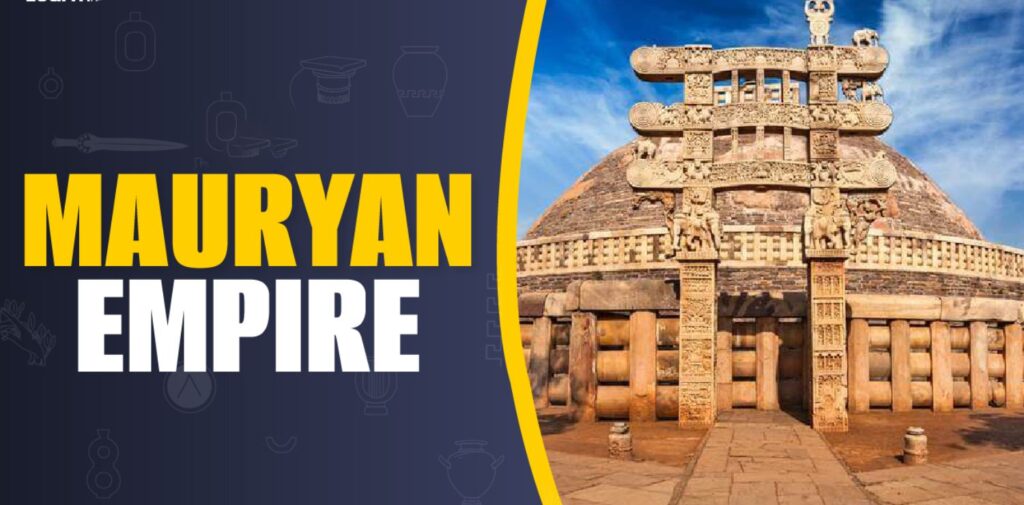India’s history is full of great empires, powerful kings, and important dynasties that helped shape the country. One such dynasty is the Satavahana Dynasty, which played a crucial role in the history of ancient India. The Satavahanas were a powerful family who ruled over parts of South India, and their reign was very important because it came between two other famous empires: the Maurya Empire and the Gupta Empire.
In this article, we will explore how the Satavahana Dynasty rose to power, what they achieved during their rule, and why they are considered a bridge between the Mauryas and the Guptas in Indian history.
The Maurya Empire: A Strong Beginning
Before we talk about the Satavahanas, let’s understand the time period just before their rise. The Maurya Empire, under the leadership of Chandragupta Maurya, was one of the most powerful empires in Indian history. The Mauryas controlled most of India, from the north to the central parts of the country. They built a strong empire with a well-organized government, a powerful army, and a rich economy.
After Chandragupta Maurya, his grandson Ashoka became the emperor. Ashoka is famous for spreading Buddhism and promoting peace across India. The Maurya Empire reached its peak under Ashoka but eventually weakened after his reign. As the empire declined, many smaller kingdoms began to rise in different parts of India.

The Decline of the Maurya Empire
After the death of Ashoka in 232 BCE, the Maurya Empire slowly lost its power. The empire faced several challenges, including weak rulers, internal conflicts, and invasions from outsiders. By around 185 BCE, the Maurya Empire had completely collapsed, and India was left without a strong, united empire. This led to a period where many small kingdoms and dynasties ruled different regions of India.
This time of instability and change in India was called the post-Mauryan period. It was during this time that the Satavahana Dynasty rose to power in the south.
The Rise of the Satavahana Dynasty
The Satavahana Dynasty started around 230 BCE in the region of Deccan (which includes parts of modern-day Maharashtra, Andhra Pradesh, Telangana, and Karnataka). The Satavahanas were not the only power in India during this time, but they became one of the most important and influential dynasties of the post-Mauryan period.
The first ruler of the Satavahana Dynasty was Simuka, who established the dynasty after the fall of the Mauryas. The Satavahanas were skilled rulers and military leaders. They initially ruled over a small region, but over time, they expanded their kingdom to cover much of central and southern India.

Key Achievements of the Satavahanas
The Satavahanas are known for several important achievements during their rule. Let’s look at a few of them:
- Expansion of Territory: The Satavahanas were excellent warriors and expanded their territory over several generations. They controlled the Deccan Plateau, which became an important center for trade, culture, and politics. Their kingdom became a bridge between the northern and southern parts of India.
- Trade and Economy: The Satavahanas were skilled in trade and commerce. They built strong trading links with other countries, including the Roman Empire and Southeast Asia. They controlled important trade routes, which allowed them to become rich and powerful. They also issued their own coins, which showed the importance of their economy.
- Cultural Contributions: The Satavahanas were patrons of the arts and culture. They supported the development of sculpture, architecture, and literature. During their reign, the famous Ajanta Caves were created, which are known for their beautiful Buddhist paintings and sculptures.
- Religious Tolerance: The Satavahanas were tolerant of different religions. While many of their rulers followed Hinduism, they also supported Buddhism and Jainism. They built many Buddhist stupas and monuments, and their rule helped Buddhism spread further in India.
- Administration: The Satavahanas established a strong administrative system to govern their large kingdom. They divided their empire into smaller regions called janapadas and appointed governors to manage these areas. They also had a well-organized army that helped protect their kingdom from invaders.
The Satavahanas and the Mauryas
The Satavahanas were an important link between the powerful Maurya Empire in the north and the future Gupta Empire in the north. While the Mauryas were known for their strength and unity, the Satavahanas were more focused on regional control and governance.
The Satavahanas ruled in the southern part of India, which was far from the Maurya Empire’s heartland. As the Maurya Empire weakened, the Satavahanas stepped in to fill the gap and became the dominant power in the Deccan region. They maintained a strong central government and established trade links that helped boost the economy of their kingdom.
Even though the Satavahanas were not as large or powerful as the Mauryas, they played an important role in maintaining order and stability in India during a time of change. Their rule helped bridge the gap between the Maurya Empire’s fall and the rise of the Gupta Empire.
The Satavahanas and the Gupta Empire
The Gupta Empire is often called the “Golden Age of India” because of its achievements in science, art, literature, and philosophy. The Gupta Empire rose to power around the 4th century CE, long after the Satavahana Dynasty had passed.
However, the Satavahanas helped lay the foundation for the Gupta Empire by maintaining stability in the Deccan region. They helped establish a cultural and economic environment that allowed the Gupta Empire to thrive later on.
One of the most significant ways the Satavahanas influenced the Gupta Empire was by fostering trade and cultural exchange. The Satavahanas had strong trade relations with many countries, and they helped set the stage for the Gupta Empire to build upon this network. Their support of Buddhism also influenced the spread of ideas and culture, which continued to grow under the Guptas.

Decline of the Satavahana Dynasty
By the 3rd century CE, the Satavahana Dynasty began to decline. After several centuries of rule, the dynasty weakened due to internal conflicts, invasions from the north, and the rise of other powerful kingdoms. The Kshatrapas in the west and the Ikshvakus in the east began to take control of the regions that had once belonged to the Satavahanas.
Despite their decline, the Satavahanas left a lasting impact on Indian history. Their rule helped maintain peace and prosperity during a time of change, and they played a crucial role in bridging the gap between two powerful empires: the Mauryas and the Guptas.
Conclusion: The Legacy of the Satavahana Dynasty
The Satavahana Dynasty may not have been as famous as the Maurya or Gupta Empires, but their contributions to Indian history were significant. They helped preserve stability in India during a period of transition and laid the groundwork for future empires.
The Satavahanas are remembered for their military strength, support of trade and culture, and religious tolerance. Their kingdom was a melting pot of different cultures, religions, and ideas, which helped make India a rich and diverse place.
In a way, the Satavahanas acted as a bridge between two of India’s most powerful empires, and their rule set the stage for the greatness of the Gupta Empire. Today, the Satavahanas are seen as an important part of India’s rich history, and their legacy continues to inspire the people of India.



